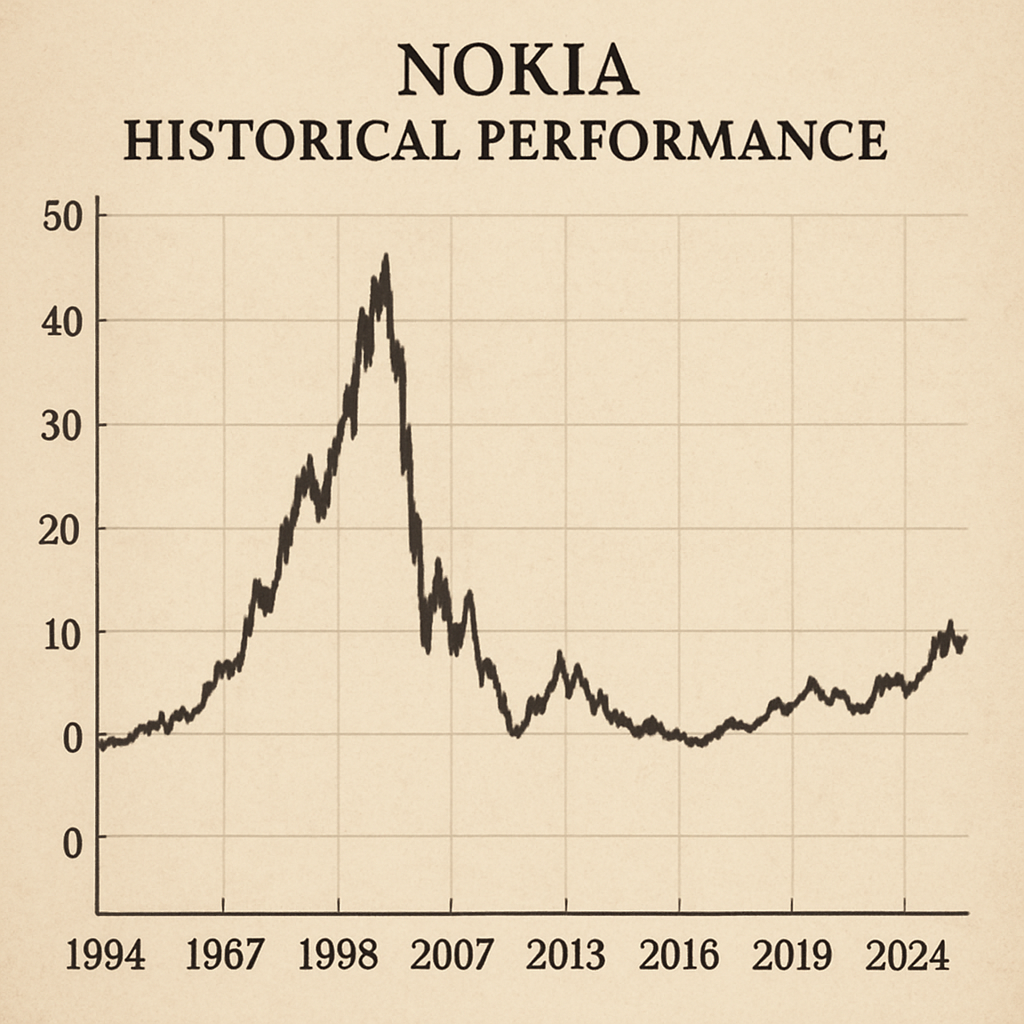Analyzing Nokia Stock Performance | Digital Market News


The journey of Nokia’s stock is a testament to the company’s resilience and adaptability in a rapidly changing industry. As we explore the various phases of Nokia’s stock performance, we will also consider the broader economic and technological contexts that have influenced its trajectory. From its early days as a market leader in mobile phones to its current focus on network infrastructure, Nokia’s evolution offers lessons in innovation and strategic repositioning. Understanding Nokia Stock is crucial for investors looking to navigate this dynamic landscape.
Nokia was originally founded in 1865 as a paper mill operation. However, it wasn’t until the late 20th century that Nokia emerged as a telecommunications giant, leading the mobile phone market. Its stock, represented by the ticker symbol NOK on the NYSE and as NOKIA on the Helsinki Stock Exchange, has experienced various phases of growth and decline. Over the years, Nokia has navigated numerous challenges and opportunities, shaping its journey in the stock market.
The analysis of Nokia Stock provides insights into the company’s strategic decisions and market trends.
Early Success and Market Leadership
During the late 1990s and early 2000s, Nokia was at the forefront of mobile technology, leading to a surge in its stock price. The company’s innovative mobile phones and expansive market reach solidified its position as a market leader, reflecting positively on its stock valuation. Investors were drawn to Nokia’s ability to capitalize on the burgeoning mobile phone market, making it a prominent choice for portfolios focused on technology and innovation.
The early success of Nokia’s stock can be attributed to its strategic vision and product innovation. By focusing on user-friendly designs and pioneering features, Nokia captured a significant share of the global mobile phone market. This period of growth not only bolstered its stock price but also established Nokia as a household name in telecommunications, setting the stage for future endeavors.
The Decline and the Comeback
The advent of smartphones marked a challenging period for Nokia, as competitors like Apple and Samsung took center stage. This shift resulted in a decline in Nokia’s market share and stock value. However, the company has since made strategic moves to regain its footing, such as its partnership with Microsoft and a focus on network infrastructure. These efforts reflect Nokia’s commitment to innovation and its ability to adapt to changing market dynamics.
Nokia’s comeback strategy has involved a significant transformation in its business model. By pivoting towards network solutions and investing in next-generation technologies like 5G, Nokia has repositioned itself in the telecommunications industry. This strategic shift has helped stabilize its stock performance and has provided a foundation for potential growth in the coming years.
Current Performance of Nokia Stock
Today, Nokia’s stock is a reflection of its efforts to adapt and innovate within the telecommunications sector. The current Nokia Oyj stock price is influenced by several factors, including market trends, technological advancements, and global economic conditions. Investors are keenly observing how Nokia’s strategic initiatives will translate into stock performance and long-term value creation.
Key Metrics and Indicators
Investors often look at specific metrics to gauge the performance of Nokia’s stock. These include the stock’s price-to-earnings (P/E) ratio, dividend yield, and market capitalization. As of the latest data, Nokia’s share price in euros on the Helsinki Stock Exchange provides insight into its valuation in the European market. These financial metrics are essential for assessing Nokia’s financial health and its potential for future growth.
In addition to traditional metrics, analysts also consider Nokia’s strategic investments and partnerships in their evaluations. By analyzing the company’s R&D expenditures and its engagement in emerging markets, investors can gain a deeper understanding of Nokia’s competitive position and growth prospects. Such insights are crucial for making informed investment decisions in a dynamic and competitive industry.
Recent Developments and News
Recent developments in Nokia’s business strategy, such as its focus on 5G technology and network solutions, have impacted its stock performance. News surrounding Nokia’s partnerships, acquisitions, and product launches are also critical in shaping investor sentiment and stock movement. The company’s efforts to expand its portfolio and enhance its technological capabilities are closely watched by investors and industry analysts alike.
The rollout of 5G networks represents a significant opportunity for Nokia to capture new market share and drive revenue growth. By leveraging its expertise in network infrastructure, Nokia aims to position itself as a leader in this transformative technology. As the demand for high-speed connectivity continues to rise, Nokia’s strategic initiatives are expected to play a pivotal role in its stock performance.
Forecasting Nokia’s Stock Price
Predicting stock prices involves analyzing various factors that could influence future performance. For Nokia, this includes market trends, technological advancements, and macroeconomic conditions. Investors must consider these elements when forecasting potential stock price movements, as they provide a framework for understanding the company’s future prospects.
Market Trends and Technological Advancements
The telecommunications industry is rapidly evolving, with 5G technology being a significant driver of change. Nokia’s involvement in 5G infrastructure and its strategic investments in research and development are likely to influence its future stock performance. As the global demand for faster and more reliable connectivity grows, Nokia’s ability to deliver cutting-edge solutions will be critical to its success.
In addition to 5G, emerging technologies such as the Internet of Things (IoT) and artificial intelligence (AI) are reshaping the telecommunications landscape. By integrating these technologies into its offerings, Nokia has the potential to enhance its value proposition and capture new growth opportunities. Investors should monitor these trends closely, as they will play a crucial role in determining Nokia’s competitive position and stock performance.
Economic Indicators and Global Market Conditions
Global economic conditions, such as interest rates, inflation, and geopolitical events, can also impact Nokia’s stock. Investors should consider these factors when forecasting the potential movement of Nokia’s stock price. Understanding the broader economic context is essential for assessing the risks and opportunities associated with investing in Nokia.
Moreover, Nokia’s global operations mean that its stock performance is influenced by a variety of regional factors. Economic policies within the European Union and other key markets can have a direct impact on Nokia’s business activities and financial results. By staying informed about these developments, investors can make more informed decisions regarding their investments in Nokia.
Understanding Nokia’s Position on the Helsinki Stock Exchange
by Egemen Şahin (https://unsplash.com/@egemensahiin)
Nokia’s presence on the Helsinki Stock Exchange is a testament to its Finnish heritage and global reach. The stock is a key component of the OMX Helsinki 25, an index that tracks the performance of the 25 most-traded stocks on the exchange. This position underscores Nokia’s significance in the Finnish market and its influence on the broader economic landscape.
Significance of NOKIA on the OMX Helsinki 25
Being part of the OMX Helsinki 25 index highlights Nokia’s importance in the Finnish market. The company’s performance within this index is a reflection of its influence on the Finnish economy and its standing among other major corporations. Investors often view Nokia’s inclusion in the index as a sign of its stability and market leadership, making it an attractive option for those seeking exposure to the Finnish market.
Nokia’s role in the OMX Helsinki 25 also provides insights into its relative performance compared to other leading companies in Finland. By analyzing its position within the index, investors can gauge Nokia’s competitive strengths and potential areas for improvement. This analysis is valuable for understanding Nokia’s strategic priorities and its ability to deliver long-term value to shareholders.
Impact of Exchange Rates and Economic Policies
For international investors, exchange rates between the euro and other currencies play a role in the valuation of Nokia’s stock. Additionally, economic policies within the European Union and Finland can influence the stock’s performance on the Helsinki Stock Exchange. Understanding these factors is crucial for assessing the risks and rewards associated with investing in Nokia, particularly for those with exposure to multiple currencies.
Moreover, fluctuations in exchange rates can impact Nokia’s financial results and its competitiveness in global markets. Investors should consider how currency movements may affect Nokia’s revenues, costs, and overall profitability. By staying informed about economic policies and exchange rate trends, investors can better navigate the complexities of investing in Nokia’s stock.
Conclusion
Nokia’s stock performance is a dynamic and multifaceted topic, influenced by historical trends, current market conditions, and future forecasts. Understanding these elements provides investors with a comprehensive view of Nokia’s position in the global market. As Nokia continues to innovate and adapt to the changing telecommunications landscape, its stock remains a point of interest for both seasoned investors and newcomers alike.
By keeping an eye on market trends, technological advancements, and economic conditions, investors can make informed decisions regarding Nokia’s stock. In summary, Nokia’s journey from a leading mobile phone manufacturer to a key player in network infrastructure showcases its resilience and adaptability. This evolution is mirrored in its stock performance, making it a valuable asset for those looking to invest in the telecommunications sector.
As the company continues to evolve and embrace new technologies, its stock is likely to remain a focal point for investors seeking growth and innovation. By understanding the complexities of Nokia’s market position and its strategic initiatives, investors can better navigate the opportunities and challenges associated with this iconic telecommunications giant.





